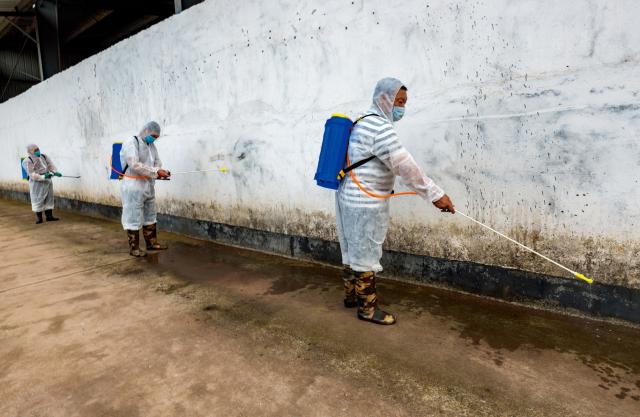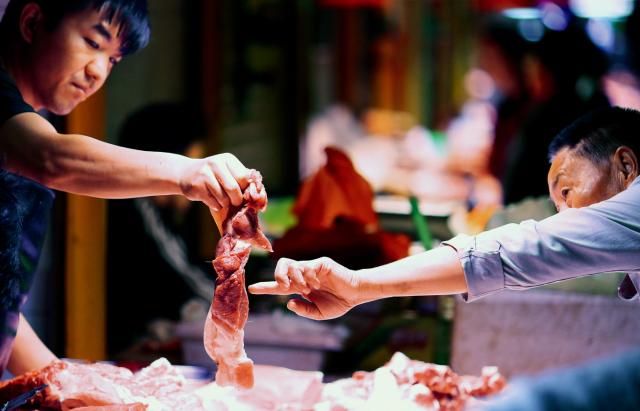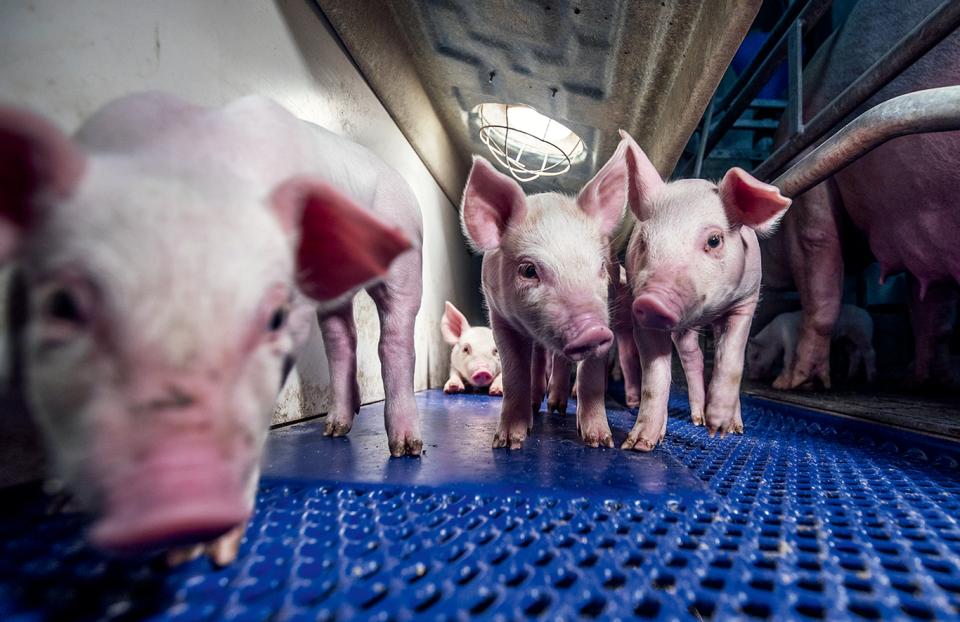In October 2019, the inventory of breeding sows in China rose by 0.6 percent, the first time in 19 months, signaling the beginning of a recovery of pig production. Yang Zhenhai, an official from China’s Ministry of Agriculture and Rural Affairs (MARA), said at a press conference that by year end, production could be back up to 80 percent of the average.
It is good news for a country that has been plagued by the highly contagious African Swine Fever (ASF) since August 2018. In the previous 16 months, more than 20 provinces were affected, with 1.19 million pigs culled by November. Pork prices continued to soar due to the shortage. In October, pork prices rose 101.3 percent year-on-year, pushing consumer price index (CPI) growth to an annual high of 3.8 percent. The price spilled over to that of beef, mutton and chicken. The price increases spread to other countries as pork imports soared in China, the world’s biggest consumer and importer. The price is expected to further spike if ASF continues to spread globally, after already being found in 40 countries and regions.
In spite of the gradual recovery, the impact of the ASF crisis continued. Panic among breeders remains, and a vaccine is still in the development phase. The pig industry will be under the shadow of ASF for some time to come. Yet the crisis is pushing forward the upgrading of China’s pig industry toward modernization and industrialization by encouraging large farms. The geographic distribution of pig production is also being readjusted. The changes are expected to help China’s pig industry become robust in its approach to disease prevention and control in the long term.
Getting Big
A major impact of ASF has been to hasten the pullout of small- and medium-sized hog farms mainly operated by individual farmers.
Since ASF broke out in Shenyang in Northeast China’s Liaoning Province in August 2018, the Chinese government has repeatedly issued instructions that ban the feeding of pigs with kitchen waste, a routine practice for pig farmers in the country. Unprocessed kitchen scraps, usually including the remains of pork or pork products, are a significant channel for the spread of the ASF virus.
It is a big blow for small- and medium-sized pig breeders, the mainstay of China’s hog production, who have mainly relied on kitchen waste for pig food. According to MARA, at the end of 2018, there were more than 26 million pig farms. Among this number, 95 percent produced less than 50 pigs a year and only 1 percent could supply more than 500 pigs annually.
Small farms are seen as presenting high risks during the ASF crisis. The outbreaks of ASF show that small- and medium-sized farms with dozens or several hundreds of pigs were the first to fall prey due to weak awareness of epidemic prevention and lax biosecurity measures. Even though authorities have not yet clearly banned small farms, many policies show a less-than encouraging attitude toward them.
In the latter half of 2018, when ASF was at its height, the government prohibited transportation of live pigs across provinces to decrease the risk of contagion. Meanwhile it allowed “point-to-point” transportation based on contracts between pig farms and cities outside the farms to ensure pork supply and sales. But this concession only applied to big farms with an inventory of at least 3,000 pigs. Smaller farms without such access suffered great losses.
In October 2018, MARA began to ask all areas to push forward the “protection of scale pig farms and breeding boars” nationwide, treating them as the hope of a recovery in the pig industry. The point of the policy was building a protective screen for big farms against infection by clearing small- and medium-sized farms within a distance of 3 kilometers. These farmers were encouraged to give up breeding or retreat from the industry. Some farmers refused. Others were willing to take the chance to escape unscathed, with government compensation.
Peng Yinglin, an engineer at a veterinary research institute in Hunan Province who joined the “protection” campaign in the province, told NewsChina that most small pig farmers cooperated, because they had been panicked about the fever and longed to get rid of the trouble. Compared to large-scale farms with hundreds or even thousands of pigs, it was easier for them to sell their stock and move on.
The result has been acceleration in the pig industry’s pace toward mass production, which had been on the government agenda for a while.
In 2018, the production of large-scale hog farms (with annual production of over 500 head) reached 49.1 percent of the total output, 38.5 percentage points up from 2003, a MARA official told the Economic Daily in September 2019. But Wang Churui, a professor from the College of Animal Science and Technology at China Agricultural University, told NewsChina that in the past 10 years, the process has been incremental, with about 5 million small- and medium-sized farms pulling out every year, until the epidemic broke out in 2018. Now the degree of industrial concentration has obviously increased, Wang said.
By October 2019, the inventory of farms with annual production of over 5,000 pigs, the number of which reaches 13,000 now, increased by 0.5 percent over September, equal to an increase of 65 such farms in a single month or at least 325,000 newly added herds. In 2018, the leading 10 companies including Wens Foodstuff Group in Guangdong Province produced only 8.6 percent of the national total output. In the first nine months of 2019, the proportion had risen to 10.8 percent.
Long-term Strategy
Wang Zuli, an expert in pig industry supervision from MARA, is more conservative about the market changes, saying that a reshuffle of the whole industry driven by ASF is hard to realize in the short term.
However, mass production is regarded as the right course not only in the present situation but also for long-term concerns of enhancing anti-risk capability. Xu Xuyang, director of the center of livestock and fisheries in Hunan Province, noted that as the proportion of large farms increases, the whole industry will grow stronger in resisting risks brought about by the cyclical fluctuations of pork supply and prices in the livestock market.
In spite of sharp falls in pork prices, if big companies or farms can ensure a strong capital chain, they will be able to survive downturns, Xu said. This means only those with sufficient capital can survive the ASF crisis and swallow the market of those without, according to Feng Yonghui, chief analyst of soozu.com, an information platform for the pig industry.
In September, the State Council issued guidance about the upgrading of the pig industry, supporting the building and expansion of large modern farms and encouraging small- and medium-sized farms to cooperate with big enterprises.
Some companies represented by Wens have already started cooperating with farmers: The farmers are only in charge of breeding, while the companies provide piglets, feed and technical guidance. Others, such as Muyang Farming, have built large farms that cover every link from breeding piglets to epidemic prevention.
The guidance also demands that by 2022 the share of large farms should climb to 58 percent, a big leap from today. Pu Hua, a research fellow at the China Academy of Agricultural Sciences, said there should be rational distribution in pursuing large farms. Before planning to build a livestock farm on a piece of land, for example, its waste absorption capacity should be considered first.
Pu noted that there is neither a shortage of breeding boars nor farms, but there is a lack of confidence. Land, disease and market fluctuations are the three burdens on hog farms. It is necessary to properly coordinate and guide the development of small- and large-scale farms and one-stop big companies, Pu said.

Workers from the animal husbandry and veterinary bureau of Jindong District in Jinhua, Zhejiang Province sterilize pig farms to prevent ASF, August 2018

Soaring pork prices were a high-profile issue in 2019
Regional Adjustment
The ASF crisis is also bringing changes to the current distribution of pig production capacity set by south-to-north relocation projects initiated by the government.
In April 2016, the Ministry of Agriculture (MARA’s predecessor)divided the nation into four different hog production areas based on their environmental carrying capacity. Curbs were put on traditional pig breeding provinces in the south, such as Hunan, Zhejiang, Fujian and Anhui, that no longer had capacity to bear more pollution, while the northeast was encouraged as a potential area of growth. By 2014, livestock breeding was already retreating from the south. By the end of 2017, 21,300 livestock farms were closed or removed and zones in which livestock farming was prohibited covered 636,000 square kilometers.
Many listed companies including Wens and Da Bei Nong Group moved to the northeast, which had plentiful corn fields, a vast flat territory and, as expected, more capacity to handle large piggeries. Despite the challenges in developing the livestock industry in the area, which include limited water supply and low temperature, as some experts had foreseen, there are high expectations. The Ministry of Agriculture’s 2016 plan demands the regions of potential growth, including Liaoning, Jilin and Heilongjiang provinces, to increase live pig production by 1-2 percentage points on average. By 2020, four northeastern areas – Liaoning, Jilin and Heilongjiang provinces and the Inner Mongolia Autonomous Region – are expected to provide over 15 percent of national output, according an instruction issued by the Ministry of Agriculture in August 2017.
The breakdown of the nationwide circulation of pigs in the ASF-crisis has interrupted the project. Starting from the latter half of 2018, after ASF was found in many provinces, cross-provincial transportation of live pigs was basically prohibited, as long-distance transportation of live pigs is a major cause of viruses spreading. It caused extreme imbalances in supply and demand and pork price variance between the south and the north as live pigs in the north could not be sent out while the south was in dire need of pork. Some experts began to predict an adjustment of the distribution.
Entering 2019, to better combat ASF, the country was divided into five major epidemic areas by MARA. Chinese Vice Premier Hu Chunhua said that it was better to give local guidance to different areas and manage them differently in fighting animal epidemics. Before that, Hu’s lecture in a video conference in December 2018 about ASF revealed the authorities’ line of thinking behind the final adjustment.
“In the past, we just wanted to develop the hog industry in regions with comparative advantages, and vice-versa. It is workable from the angle of economic benefits, but absolutely problematic in terms of stopping epidemics,” Hu said, stressing that the distribution of hog farming should be based on the long-term demand of preventing and controlling major animal diseases such as ASF.
Hu said that all provinces should keep a certain scale of production and keep the balance of intra-regional supply and demand. He suggested that Southern China and areas surrounding large urban areas encourage building farming enterprises of high quality to be self-sufficient in pork production, instead of simply banning or closing pig farms. “It means the distribution of [pig] production needs to be adjusted,” Hu said, stressing that it is not an expedient measure

 Old Version
Old Version

